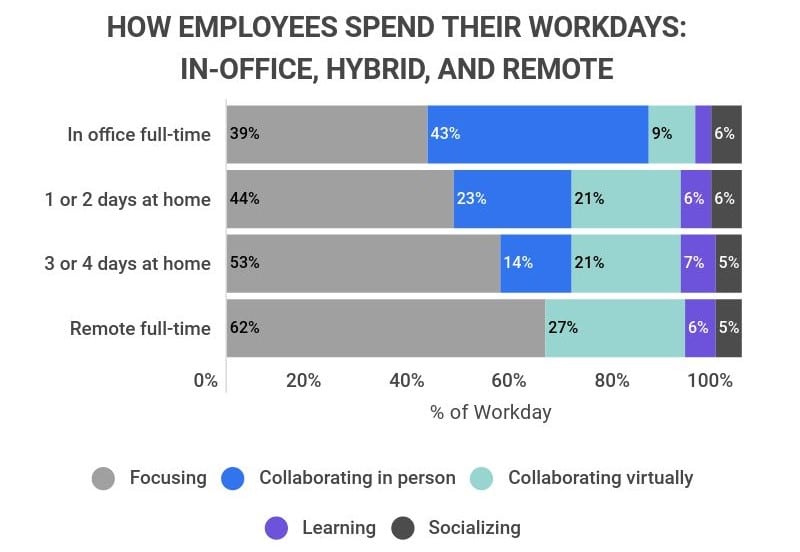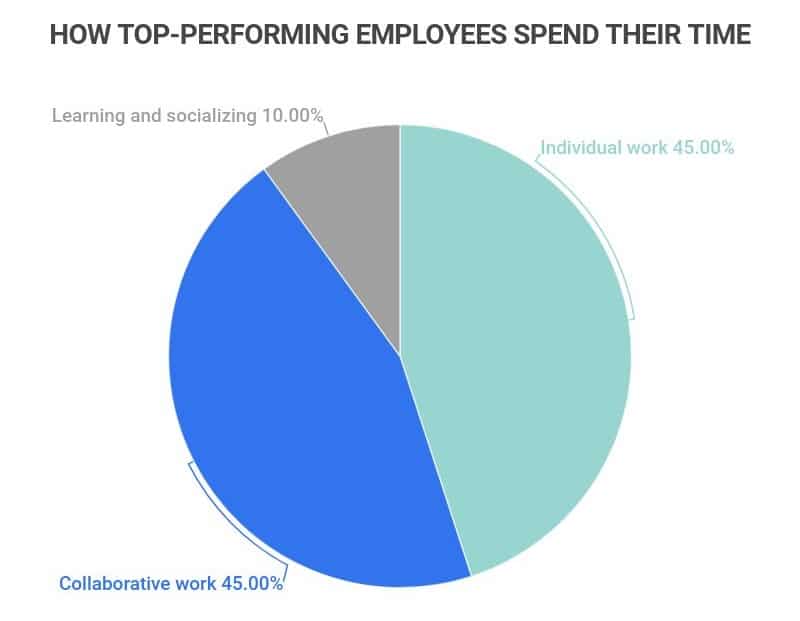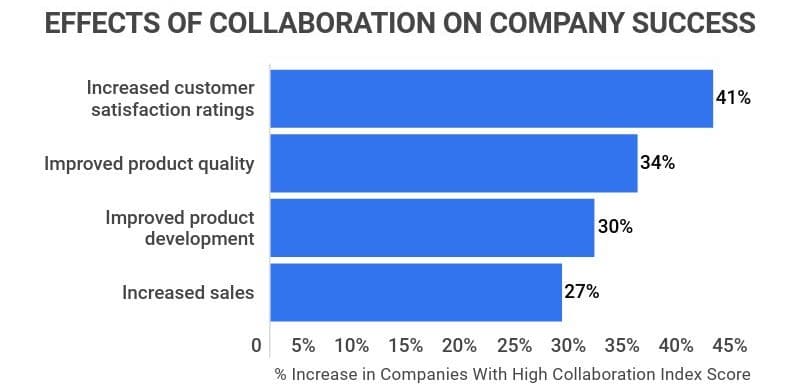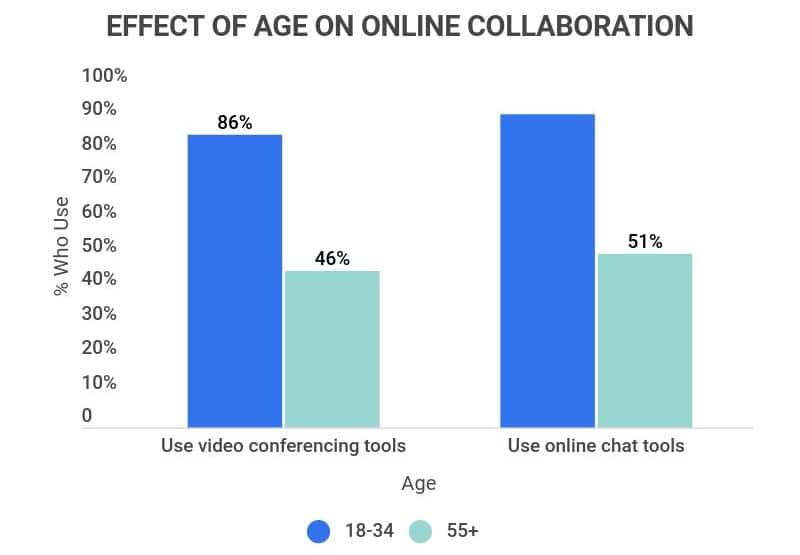- Workplace Statistics
- Time Management Statistics
- Employee Wellness Statistics
- Employment Discrimination Statistics
- Employee Recognition Statistics
- Employee Referral Statistics
- Workplace Violence Statistics
- Gamification Statistics
- Employee Feedback Statistics
- Agile Statistics
- Productivity Statistics
- Meeting Statistics
- Cell Phones At Work Statistics
- Social Media At Work Statistics
- Workplace Injury Statistics
- Workplace Stress Statistics
- Leadership Statistics
- Workplace Collaboration Statistics
- Job Satisfaction Statistics
- Paid Holiday Statistics
- Communication In The Workplace Statistics
- Wasting Time At Work Statistics
- 4-day Workweek Statistics
Workplace collaboration research summary. Workplace collaboration is a skill highly desired by employers and hiring managers in almost every industry across the United States. Below we’ll break down our research on online teamwork and collaboration statistics:
-
More than 50% of workers in the United States say their jobs are reliant on collaboration.
-
About 75% of employees rate teamwork and collaboration as being very important.
-
56% of employers use online collaboration tools and social media to communicate with employees.
-
86% of employees in leadership positions blame lack of collaboration as the top reason for workplace failures.
-
Companies that promote collaboration and communication at work have been linked to reducing employee turnover rates by 50%.
-
Employees are, on average, 17% more satisfied with their job when they engage in collaboration at work.
-
Over the last 20 years, workplace collaboration has increased by at least 50%.
For further analysis, we broke down the data in the following ways:
Benefits | Remote Work | Trends | Issues

General workplace collaboration and teamwork statistics
Workplace collaboration is prized in any workplace, as it allows employees to work effectively in teams. Here are some examples of how workplace collaboration impacts teamwork:
-
People who collaborate on the job and who have access to digital collaboration tools are up to 17% more satisfied with their job and workplace culture.
Research is very clear that employees who collaborate at work are generally happier than those that do not. It’s also important that employees have the necessary resources to make collaboration convenient and efficient.
-
Top-performing workers spend 45% of their time on the job working individually, 45% of their time on the job working collaboratively, and 10% of their time on the job learning and socializing.
Data suggests that the highest performing employees working for top U.S. companies spend an equal amount of time engaging in individual and collaborative work.
-
Individuals who work in collaborative settings at work are more than 50% more effective at completing tasks than those who work independently.
Working collaboratively and collectively leads to better on-the-job performance rates, according to a Stanford study. Employees who worked collaboratively were 64% more likely to stick to their assigned task than their solitary peers.
In addition, people who engaged in collaboration at work also reported higher levels of engagement, higher success rates, and decreased fatigue levels.
-
52% of employees in the U.S. rate teamwork as being very important.
Most American workers rate collaboration as a key element for their career success. 48% of professional and technical employees, 54% of administrative employees, 57% of managers and directors, and 66% of senior and executive employees say that their job is reliant on in-person collaboration, according to a workplace survey by Gensler.
-
The majority of employees feel that workplace collaboration is lacking at their company.
Only 9% of surveyed employees reported that their place of employment had very effective sharing and collaboration tools and systems in a Deloitte study. An additional 39% of respondents said that their company’s collaboration methods were somewhat effective.
-
39% of employees say people at their organization don’t collaborate enough.
According to a global survey on workplace collaboration, 39% of surveyed employees feel that their peers don’t collaborate enough. The same survey found that only 27% of people are confident in communicating at work.
-
75% of people value workplace collaboration as being “very important.”
Three in four surveyed employees, or 75%, rate teamwork and collaboration at work as “very important.” Millennials, who represent almost half of the workforce in the United States, are the most likely age group to value workplace collaboration.



Benefits of collaboration statistics
Workplace collaboration has many benefits. From increased moral to improved finances, here are some examples of the benefits of workplace collaboration:
-
Collaborating on tasks and sharing ideas is valued at $1,660 per employee each year and the quality improvements made as a result of workplace collaboration are valued at $2,517 per employee each year.
An international study performed by Deloitte found that workplace collaboration saves companies thousands of dollars per employee.
-
Teamwork and workplace collaboration efforts increase company sales by 27%.
A company’s collaboration index increases sales by 27% and improves customer satisfaction ratings by 41%, according to data from Frost & Sullivan. The study also showed that collaboration improves product quality by 34% and improves product development by 30%.
-
Employees who work for collaborative companies are 22% more likely to believe that their employer cares about their morale.
Collaboration at work directly affects employees’ morale and loyalty levels. Employees working for companies with effective collaboration initiatives are about 22% more likely to believe that their employer cares about their morale, thus making collaborative employees more loyal to their organizations than their peers.
-
Companies that promote collaboration at work have five times better performance rates than those that do not.
Companies that promote collaborative working environments are five times more likely to be high performers than companies with fewer employee collaboration initiatives.
-
Collaboration decreases the likelihood of burnout and work-related stress.
80% of employees feel stressed at work, and studies show that team dynamics are linked to 92% of work-related stress. Experts suggest that meaningful and dynamic communication and collaboration at work can significantly improve team dynamics, lowering stress levels and burnout rates.
-
Successful collaboration at work improves innovation by 30%.
Companies that collaborate are 30% more innovative and at least 36% more productive than those that don’t, according to numbers released by Frost & Sullivan.

Online collaboration statistics
Workplace collaboration can be more difficult for remote workers, but not impossible. To find out more about workplace collaboration in online spaces, we’ve gathered some crucial statistics:
-
People working from home in full-time positions spend 48% less time collaborating than they would if they were working from the office.
A poll showed that this reduction in collaboration among remote employees working from home is largely due to the shift in the work environment due to the COVID-19 pandemic.
-
People working online from home spend the majority of their work time focusing rather than collaborating.
According to research, online employees spend 62% of their time focusing, 27% of their time collaborating, 6% of their time learning, and 5% of their time socializing.
-
About 45% of employees feel that online collaboration via social networks boosts workplace productivity.
About 45% of employees born between 1946 and 2000 think that collaborating using social networks at work boosts on-the-job productivity levels. When broken down by generation, 40% of Boomers, 46% of Gen X, and 50% of Millennials reported that social network collaboration at work could boost productivity.
-
Although workplace collaboration has been shown to improve productivity, online collaboration tools can lead to increased distractions in the workplace.
Research on collaboration in the online labor force has shown a couple of things. When using online collaboration tools at work, 41% of distractions are caused by having personal conversations on the job and 39% of distractions are caused by incoming requests taking away from current tasks and projects.
-
Approximately 90% of businesses use some kind of online collaboration tool for internal communications.
Research shows that 31% of businesses preferred to use Microsoft Teams, 27% of businesses preferred to use Microsoft Skype for Business, 21% of businesses preferred to use Google Chat, 15% of businesses preferred to use Cisco WebEx Teams, and 13% of businesses preferred to use Zoom.
Preferred online collaboration tools
Digital Collaboration Tool Percentage of Companies Microsoft Teams 31% Microsoft Skype for Business 27% Google Chat 21% Cisco WebEx Teams 15% Zoom 13% -
In 2019, 48% of employees used video conferencing at work more often than they did in the previous two years on the job.
According to the “2019 Impact Of Video Conferencing Report” released by Lifesize, more people were relying on video collaboration tools at work in 2019 than in the recent past.
The study found that 25% of employees aged 18 to 29 used video conferencing on a daily basis at work, and 51% of survey respondents thought that companies using video conferencing were more innovative.
-
40% of employees wish that companies would enforce stricter rules around the use of online collaboration tools at work.
Two in five employees want stricter rules regarding collaboration app usage at work.
The same report revealed that 60% of employees think that stricter rules would help improve work-life balance, and 42% of employees think that enforcing rules would set a firm expectation on the usage of online collaboration tools.

Collaboration in the workplace trends
Workplace collaboration has always been important, which is why employers and workers are always looking for new ways to collaborate successfully. To see where workplace collaboration might be headed in the future, we’ve gathered all of the latest trends:
-
Prior to the COVID crisis, employees spent 43% of their workweek collaborating. During 2020, that number fell to 27%.
Weekly workplace collaboration fell by 37% due to the global pandemic, according to research by Gensler, an organization that’s tracked workplace trends for more than 15 years. The shift towards work-from-home dramatically reduced the rate of workplace collaboration.
-
The global collaboration tools and software market is expected to see a CAGR of 9.5% from 2022 to 2030.
This would increase its value to $56.67 billion, up from its $21.69 billion valuation in 2021. The U.S. market was valued at $4.8 billion the same year.
-
Younger generations are overwhelmingly more likely than older generations to engage in workplace collaboration and use online collaboration tools at work.
Employees over the age of 55 are 41% more likely to prefer working on their own compared to employees aged 25 to 34.
The research also showed that 86% of employees aged 25 to 34 use video conferencing tools at work compared to just 46% of employees aged 55 and older. Similarly, 92% of employees aged 18 to 34 make use of online chat tools to collaborate at work compared to just 51% of employees aged 55 and older.

Collaboration issues in the workplace statistics
Collaboration is critical, but not always easy to achieve. Companies often don’t foster collaboration as much as they should, and workers might be less likely to collaborate during hard times. Overall, here are examples of collaboration issues in the workplace:
-
Most businesses reward individual achievements, not team achievements.
Research suggests that an overwhelming lack of incentives and rewards is the most common explanation for the lack of workplace collaboration. A study that examined more than 1,100 companies found that the key element of productive collaboration is purpose.
-
Individuals are less likely to engage in workplace collaboration during recessions.
A recent study that analyzed 60,000 responses from the World Values Survey found that recessions promote a dog-eat-dog work style and lead to less collaboration on the job. This sentiment is echoed by a 2013 study that found that money had a major impact on people’s willingness to collaborate at work.
-
About 33% of companies undervalue the benefit of using social networks as a workplace collaboration tool.
One in three companies undervalues social networks as a professional collaboration tool even though research shows that every generation values social tools at work.
-
Poor communication and poor collaboration are one of the primary causes of workplace stress.
39% of respondents cited “poor communication” as a top stressor at work in a report on workplace stress in the United States and the United Kingdom. An additional 28% of respondents said that “team members not pulling their weight on projects” was another leading cause of workplace stress.
-
Spending too much time collaborating could lead to unfinished tasks.
Research shows that the average employee spends 85% of their workweek communicating via email, attending meetings, and talking on the phone, which could leave little time to perform other tasks expected of them.
Workplace collaboration statistics FAQ
-
How much does collaboration increase productivity?
Collaboration increases productivity by 25% or more. This comprehensive workplace study by McKinsey looked specifically at the effect of improving collaboration through improved internal social tools, so it’s likely that the total effect of collaboration increases productivity by even more than 25%.
-
What percentage of jobs use teamwork?
More than 50% of jobs require teamwork. In fact, 52% of American workers rate workplace collaboration as “very important.” A smaller proportion of entry-level workers feel that teamwork is very important compared to senior and executive roles.
However, even at the lowest levels of an organization, 48% of employees feel that collaboration is essential for their work.
-
How many people should work in a team?
Between 4 to 9 people should work in a team for optimal success. Smaller teams are prone to more delays and skills/knowledge gaps, whereas larger teams often lack cohesion, efficiency, and accountability.
Research has shown that the most productive teams consist of a happy medium of around 6 people.
-
How do you measure collaboration in the workplace?
Collaboration in the workplace can be measured through financial KPIs that track Net Profit, Revenue Growth Rate, and Average Revenue Per User. Here are those metrics outlined:
-
Financial KPIs. This metric is used to measure and compare a company’s performance to others in the same industry. It entails measurements like revenue growth, profit margins, expenses, cash management, and more.
-
Revenue Growth Rate. Measuring how a company’s revenue changes over time can be a great way to identify the success of the collaboration. The rate of Revenue Growth is typically calculated by comparing the increase or decrease in annual revenue between two different time periods.
-
Average Revenue Per User (ARPU). For some companies ARPU is especially useful for measuring collaboration, as it shows growth among clients, users, or subscribers. ARPU is calculated by dividing the total revenue by the number of consumers who fit those categories.
-
Final Thoughts
When it comes to succeeding at work, collaborating and effectively communicating with your colleagues, clients, and supervisors is a no-brainer. Time and time again, most data show that on-the-job collaboration improves efficiency, creates a better workplace dynamic, and increases profitability.
Although there can be some drawbacks to workplace collaboration, like stress and a lack of recognition for team achievements, more than half of the labor force in the United States relies on collaboration at work and rates teamwork as being very important to career success. In fact, most employees blame workplace failures on the lack of collaboration.
Over the past 50 years, workplace collaboration has increased by at least 50%, and it has no signs of slowing down now.
Today, online collaboration tools are a leading platform used for effective collaboration at work. With 56% of employers across the nation using online collaboration tools, effective digital communication could be the key to continued career success.
References
-
Forbes. “New Study Finds That Collaboration Drives Workplace Performance.” Accessed on 8/8/2021.
-
Fortune. “How Companies Can Reinvigorate Collaboration Post COVID.” Accessed on 8/8/2021.
-
Deloitte. “Digital Collaboration: Delivering Innovation, Productivity, And Happiness.” Accessed on 8/8/2021.
-
Queens University Of Charlotte. “Communicating In The Modern Workplace.” Accessed on 8/8/2021.
-
The Future Organization. “The Impact Of Collaboration On Enterprise Business Performance.” Accessed on 8/8/2021.
-
Harvard Business Review. “To Reduce Burnout On Your Team, Give People A Sense Of Control.” Accessed on 8/8/2021.
-
Statista. “Collaboration Software Market Revenues From 2015 to 2024.” Accessed on 8/8/2021.
-
ZDNet. “Employees Crave Stricter Rules Around Collaboration App Usage.” Accessed on 8/8/2021.
-
TechRadar. “Generational Differences In Collaboration At Work.” Accessed on 8/8/2021.
-
Globe Newswire. “Lifesize 2019 Impact Of Video Conferencing Report: More Collaborative Workplace Cultures Have Led To Spike In Video Communication.” Accessed on 8/8/2021.
-
Wrike. “Wrike Survey Reveals Communication And Collaboration Challenges Are Leading Sources Of Stress At Work.” Accessed on 8/8/2021.
-
Wharton University Of Pennsylvania. “Too Much Togetherness? The Downside Of Workplace Collaboration.” Accessed on 8/8/2021.
-
Gensler. “U.S. Workplace Survey Summer/Fall 2020” Accessed on 1/26/2022.
-
Grand View Research. “Team Collaboration Software Market Size Report, 2020” Accessed on 2/16/2023.
- Workplace Statistics
- Time Management Statistics
- Employee Wellness Statistics
- Employment Discrimination Statistics
- Employee Recognition Statistics
- Employee Referral Statistics
- Workplace Violence Statistics
- Gamification Statistics
- Employee Feedback Statistics
- Agile Statistics
- Productivity Statistics
- Meeting Statistics
- Cell Phones At Work Statistics
- Social Media At Work Statistics
- Workplace Injury Statistics
- Workplace Stress Statistics
- Leadership Statistics
- Workplace Collaboration Statistics
- Job Satisfaction Statistics
- Paid Holiday Statistics
- Communication In The Workplace Statistics
- Wasting Time At Work Statistics
- 4-day Workweek Statistics





